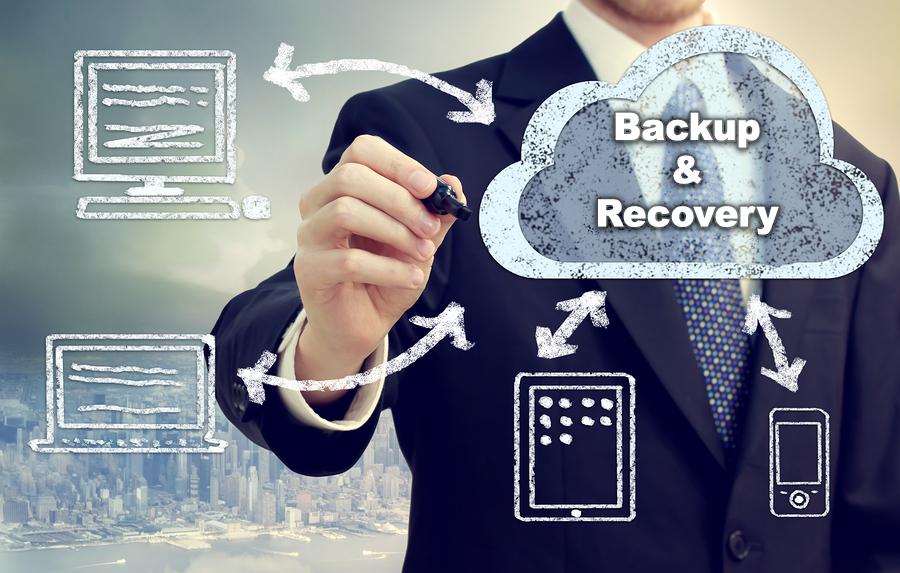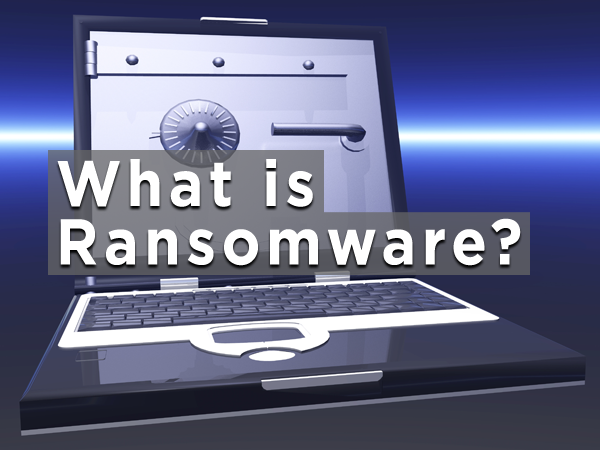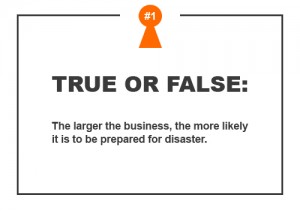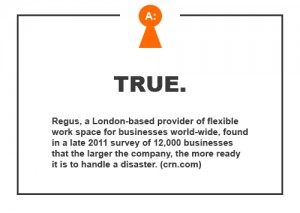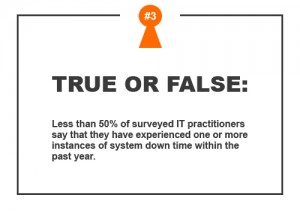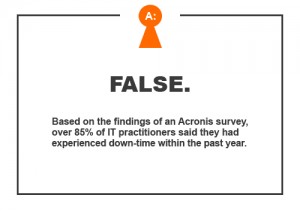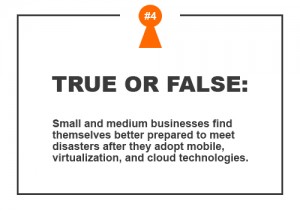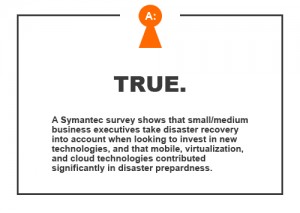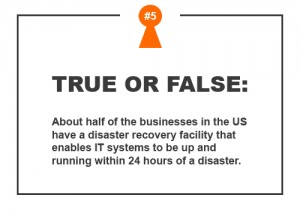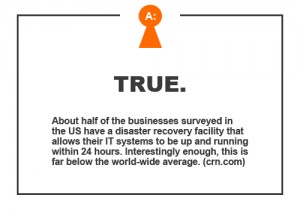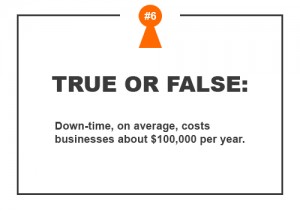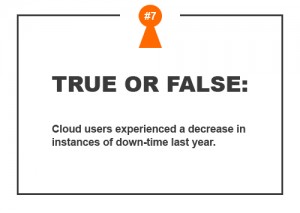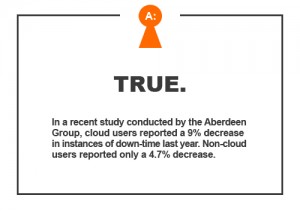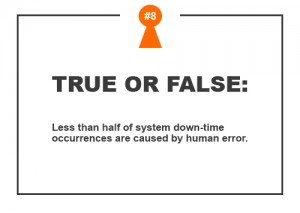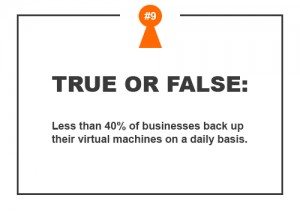Archive for the ‘disaster recovery’ tag
Reviewing Your Company’s Backup and Recovery Plan no comments
Is your company prepared for a catastrophe that could result in the loss of your data? You’ve most likely taken out insurance to protect yourself against natural disasters, robberies and similar catastrophic events. Your data should be no different. The only difference is that this type of insurance involves backing up your data and IT infrastructure, so that your business remains online and operational, even during one of those catastrophic situations mentioned above or something like a hardware failure or a disastrous infection. Here are some key things to focus on when reviewing your company’s existing plan or during the development of a new one:
What to Back Up
Determining what needs to be backed up should be addressed before you look at how you back it up. Do you want to back up everything that is located on computers at the office? What about data located on laptops or cellphones that are taken to and from home? Is your email or website backed up? Do you want them to be? Do you possess physical forms and documents that you want scanned into electronic form and then backed up in that form so that you are set if something such as a fire or flood destroys the hard copies?
You can back up everything, otherwise known as a full backup. This obviously requires the most storage space as well as the most time. However, it helps ensure that you will be completely back up and running in a timely manner if some disaster causes your primary data source to no longer be accessible.
However, this is not always necessary. In that case, consider an incremental or partial backup. An incremental backup involves the backing up of only files that had been created or changed since the last time your data had been backed up. This tends to be much quicker, but you do need to then ensure that you have access to several incremental backups in order to fully restore your data. It can also be difficult to organize your files or to find a specific one if you are downloading several incremental backups after disaster struck.
A partial backup means that you are only backing up part of your data, presumably the most valuable portion. However, the difference between a partial backup and a complete backup is usually minimal, meaning that, with a few exceptions, you might as well just back up everything.
Focus initially on the most important data, whatever would cause the most damage were the information to become inaccessible. These files should also be backed up more often. Of course, it does take time and money to back up your information, but it is well worth it when you consider the repercussions of losing access to it for a considerable time period or forever.
Local / Onsite Backups
Local or onsite backups involve copying and storing your data on a server or drive that is located on the same premises as your primary data source. The most significant benefit of this plan is that you can always have your secondary data right there. If something happens to your primary computer system, it’s normally easy to start utilizing the backup sources, and you don’t need to have an internet connection to do so. The cost of utilizing this type of data backup is usually relatively low, and the process of backing up your data with this method is normally pretty simple.
However, several significant disadvantages exist as well. A natural disaster such as a flood or hurricane that destroys your office or original data source will often take out your backup data too if it’s being kept onsite. And if somebody breaks in and steals your primary data, doing the same to your secondary data too can be done on the same trip.
Cloud Backup
Those taking advantage of cloud backup options will have their data sent to a remote data center on a regular basis. Probably the most significant benefit of going this route is that multiple copies of your data will can be made to stored on multiple servers located in a variety of places. That way if something disastrous happened to one place or server where your backup data was stored, you could simply access an alternate. Your data is safe at these locations as it is encrypted before being stored, and you have instantly scalable storage capacity. Another benefit is being able to automate the process so that you are not dependent on somebody remembering to back up the data.
An indirect benefit of utilizing a cloud backup method is that those who are authorized to do so can easily access the data, whether they are located across town or even on the other side of the world. This is a great benefit for organizations with multiple locations or remote staff. It’s also generally more cost effective than backing up your data onsite, due to not needing to purchase your own backup equipment. However, make sure that you research and trust the data center provider you are using to back up your data remotely.
Cloud Replication
Cloud Replication allows for the restoration of data to a virtualized server. Utilizing an off-site data center’s cloud infrastructure, data can be made available instantly, then accessed remotely from anywhere in the world over multiple, redundant, high speed networks. This removes the bottleneck of local internet service providers bandwidth availability, and saves potentially hours of business critical time by bypassing the need to wait for your onsite systems to restore and be back in working order.
Should a disaster occur in which your infrastructure is no longer available or accessible to be restored, the need to purchase new hardware can be completely eliminated. Utilizing a Cloud Replication solution can have your business back online in minutes, not days. Employees can continue their work from home, remotely accessing images of their old workstations running live in the cloud, ensuring your business does not skip a beat.
Whether it be an office fire, hardware failure, employee error, or malware infection, IT disasters are inevitable. That’s why it is critical that you have a plan in place. Don’t gamble with your company’s data, call TurnKey Internet at 518-618-0999 and receive a free consultation of your company’s Disaster Recovery Plan. Learn more at www.TurnKeyInternet.net/myplan
Follow Us :
Share :
Ransomware, Careless Employees, and IT Gremlins – Better Have Backups no comments
From buying insurance policies to installing security cameras, you take every possible step to protect your business from disaster. But you power on your computer and are met with a screen that claims to have encrypted all of your files. Unless you pay a fee before the timer expires, the program will delete your files forever. Although each situation will be different, this is what will likely happen when ransomware strikes your business.
If you store your customer data, tax information, contracts or any other important files on your network, your business can suffer. Not only will ransomware lock your files, but it can also destroy your reputation if your customers find out that your servers are not secure. When the future of your business is on the line, you can’t afford to leave yourself exposed to the threat.
Taking preventative steps to minimize the effects ransomware is a lot easier than trying to remove it. Once the ransomware takes over a computer, you won’t be able to recover your files without paying the ransom. To ensure your business is ready for a ransomware attack, you should focus on some key areas:
Employee Education
Criminals and hackers will use a range of tactics to infect a business or organization with their malicious software, including sending an email containing an infected link to one of your employees. The infected email can even be made to appear as if it came from one of your company’s email addresses. The moment your employee clicks on the link, the ransomware will jump into action and hold your files hostage. Also, if a member of your team is infected at home and brings a flash drive to work, you could have a problem on your hands.
Teaching your employees how to stay safe online is one of the top ways to protect your business from such attacks. If you want to avoid taking unneeded risks, prevent your employees from using personal devices on your network. Ensure that each person who works for you knows not to click on links unless they are sure that no danger is present. When someone from your company sends an email, have your team call the person to confirm that the email is legitimate. In addition to showing people how to stay safe when they use your network, consider putting policies in place to add an extra layer of protection.
Cloud Backups
Ransomware can easily spread across your office network, encrypting and possibly deleting all of your company’s files. If you want to do everything that you can to avoid such a disaster, consider getting an off-site dedicated server or cloud backup solution for your business. Doing so will allow you to store copies of your files outside of your infected office network, so that you can recover them after an attack.
One thing to keep in mind when searching for a cloud backup provider is storage limits. If your business has a large amount of data that will need to be backed up into the cloud, consider looking for a provider that offers an unlimited storage option.
Disaster Recovery as a Service (DRaaS)
No matter how prepared, you can never totally eliminate the threat of ransomware. Even if you have taken the step to backup all of you company’s critical files, you can still be left with the daunting task of restoring all that data as well as needing to recover your company’s entire IT infrastructure. This is where Disaster Recovery as a Service or DRaaS comes in.
With a DRaaS solution, you can have a complete backup of your business’s vital IT infrastructure at an off-site datacenter. Entire operating systems, whether it be physical or virtual, databases or individual files and folders can all safely and securely be replicated to a datacenter. Data can then be securely pushed back down to your office location, or it can even be restored into a virtual cloud environment, utilizing Cloud Replication.
Cloud Replication
DRaaS solutions that feature Cloud Replication allow for the restoration of data to a virtualized server. Utilizing an off-site datacenter’s cloud infrastructure, data can be made available instantly, then accessed remotely from anywhere in the world over multiple, redundant, high speed networks. This removes the bottleneck of local internet service providers bandwidth availability, and saves potentially hours of business critical time by bypassing the need to wait for your onsite systems to restore and be back in working order.
Should a disaster occur in which your infrastructure is no longer available or accessible to be restored, the need to purchase new hardware can be completely eliminated. Utilizing a DRaaS solution can have your business back online in minutes, not days. Employees can continue their work from home, remotely accessing images of their old workstations running live in the cloud, ensuring your business does not skip a beat.
Be Prepared When IT Disasters Strike
TurnKey Internet is Upstate New York’s only Tier IV featured Data Center providing 100% Guaranteed Uptime. We offer Colocation, IT Infrastructure, New York to California replication, on-premise 24×7 expert local staff, and the Cloud solutions to help your business succeed.
TurnKey’s DRaaS (Disaster Recovery as a Service) solution offers live Cloud Replication for your on-premise IT infrastructure to our Tier IV featured Data Center in a secure virtualized hybrid environment that is instantly available and securely accessed remotely from anywhere.
Don’t gamble, call TurnKey Internet at 518-618-0999 or visit turnkeyinternet.net/myplan to receive a FREE consultation of your company’s Disaster Recovery Plan.
Follow Us :
Share :
What is Ransomware? no comments
Over the past few years malware infections have seen an exponential growth. They are becoming more sophisticated, using newer methods that are not only harder to detect, but also require less user interaction. One of the more prominent forms of malware, especially in recent days, is called Ransomware.
Ransomware is form of malware, or malicious software, that carries out its attack by encrypting the data on a computer or server, then blocking access to that data until a ransom is paid.
Security researchers report attackers are not only upgrading their ransomware to make it more unbreakable, they are also using unique methods of distribution. In some cases, these methods require no user interaction at all. In the past, most ransomware infections occurred via phishing attacks, which required a user to click on a malicious website or email link. But these newer attacks are less dependent on user interaction and more dependent on unpatched software or Operating System vulnerabilities or poor security practices.
Ransomware is spreading faster and is self-replicating within organizations and businesses before coordinating ransom demands. It is critical that companies take the needed steps to prepare and protect their network as well as their local and cloud-based servers. The damage of ransomware encrypting and disabling all of your corporate data within seconds or minutes is real and has lead to some high profile cases including hospitals being locked out of all their data due to ransomware.
There are some easy yet vital best practices you should follow to protect yourself and your company from becoming victims of ransomware. First and by far the most important, backup your data. Second, consistently keep your software and systems up-to-date. Third, make sure you are utilizing some form of antivirus and malware protection software on your PC’s and servers. Finally, BACKUP YOUR DATA! Yes, I know I said that already, but this step is so critical it’s worth mentioning twice. If you don’t currently have a backup solution, there are many cloud-based disaster recovery and backup options to choose from, such as TurnKey Vault.
Your primary goal is to protect your users, not just your network. Whether they are on a laptop, tablet or smartphone, your users need to be protected everywhere. However, it is unreasonable to assume that you will be 100% protected from every threat that exists. New more advanced methods to attack computers and encrypt their files are popping up everyday. This is why your number one priority should be to backup your data regularly.
Make sure whatever backup solution you deploy offers data encryption, supports both desktop PC’s and Macs, as well as Linux and Windows based servers. A backup solution like TurnKey Vault offers live cloud replication which will get you back on your feet in minutes in case of a true disaster by creating a live cloud-based copy of any PC workstation or Server accessible from anywhere over the Internet to get you access to your data and applications quickly.
Follow Us :
Share :
Disaster Recovery Plan: Is Your Business Prepared? 1 comment
Disaster can strike at any time. From earthquakes to tornadoes to hurricanes, there is a wide variety of natural disasters that can take place and cause incredible damage to a business. In addition to natural disasters, businesses may also be harmed by fires, floods or IT issues. It is essential that businesses of all sizes have a comprehensive Disaster Recovery Plan.
Here are some of the issues that a business may face following a disaster and how they can ensure business continuity in the aftermath.
Dealing With Displacement
Many disasters can result in major physical damage to buildings and stores. This means that companies should have both an evacuation plan in place and a plan for dealing with the displacement that generally comes with major damage to a building. It may be days or weeks before a building is suitable for people to work in after a fire or a flood, and employees will still often still need a centralized location to work out of.
Organizations should determine ahead of time if employees will be expected to telecommute, if arrangements will be made to rent other facilities or if staff will be routed to other business locations. Some businesses may want to find a middle-ground where employees meet at certain locations a few times a week but do the majority of their work from home.
Employee Communication Systems
One of the major issues that companies run into, even when not dealing with a disaster, is how to communicate effectively. In many cases when there is a disaster, employees are no longer able to go to their normal workplace or call into a specific office to find out what is going on. Therefore, it’s important that a communication system is set up before a problem arises and one is needed.
There are a variety of ways to tackle communications following a disaster, including having a certain phone number that employees call to find out updates about the business. Alternatively, a mailing list or web page can be set up that allows employees to find out the status of a business and what they are expected to do.
Keep Copies of Physical Records
Although the paperless office has been a dream for decades, few businesses are completely digital. Most companies offer paper invoices, and customer contracts are almost always printed and signed in pen. This means that there is often a large amount of paperwork that should be stored in a computer but is not.
To ensure that physical records will still be accessible after a disaster, businesses should have a system in place for making and keeping copies of paperwork. A scanner can be employed to capture images of paperwork, and there are object character recognition software suites that can turn the scanned images into text. Once paperwork is in a computer system, it can then be uploaded to the cloud.
This brings us to one of, if not the most important component of a successful Disaster Recovery Plan, utilizing the cloud
Take Advantage of The Cloud
Cloud computing has changed the way that many businesses handle disaster recovery and business continuity planning. One of the biggest changes that being able to use a cloud backup has brought to the business world is the ability for smaller organizations to use the type of data recovery systems that historically were only available to large organizations.
Now, any business’ disaster recovery plan can include complete data backups that are off-site and redundant. Prior to cloud backup systems, businesses were often limited to storing data backups on-site. If a fire broke out or servers were damaged in some other way, on-site data would be lost. Off-site backups frequently required manually making copies of data and/or moving storage media to a different location before cloud computing streamlined the backup process.
The cloud now allows data to be saved automatically, and many businesses are working off of cloud-based systems at all times. Another major benefit of using the cloud for backups is that many other types of data storage have significant failure rates. Tapes, in particular, were used for decades as a method of storing backup data, but it has been found that they have about a 10 percent failure rate.
Cloud computing offers redundant file storage, so unlike with tapes or even hard drives that could potentially fail, data saved to the cloud is almost guaranteed to always be available. Systems can be set in place to back up data automatically, and cloud storage allows you to keep multiple copies of records with different time-stamps.
Another major benefit of using these types of backup systems is that they can be used almost anywhere. So long as an employee has access to the Internet, they should be able to log into the cloud and access business files and applications.
The Cloud is helping businesses recover their most critical systems and data faster, while also avoiding the expensive infrastructure costs of onsite or in-office datacenters. Leveraging the cloud is by far one of the best, most cost effective ways to protect your company and ensure business continuity when disaster strikes.
Follow Us :
Share :
TurnKey Internet, Inc Launches Cloud Backup with Business Continuity Service no comments
TurnKey Internet, Inc Launches Cloud Backup with Business Continuity Service
 LATHAM, NEW YORK (September 22nd, 2015) – Sustainable IT solutions provider TurnKey Internet, Inc. announced today the launch of their TurnKey Vault Secure Cloud Backup service. The all new product delivers next-generation online backup services focused on business continuity and disaster recovery (BCDR) to individuals, businesses and large scale organizations across the globe.
LATHAM, NEW YORK (September 22nd, 2015) – Sustainable IT solutions provider TurnKey Internet, Inc. announced today the launch of their TurnKey Vault Secure Cloud Backup service. The all new product delivers next-generation online backup services focused on business continuity and disaster recovery (BCDR) to individuals, businesses and large scale organizations across the globe.
TurnKey Vault offers next-generation backup technology including bare metal recovery, Linux, Windows and Mac operating system support, encrypted data protection, as well as backups for enterprise databases such as Oracle, MSSQL and MySQL. TurnKey Vault fills the void that exists with typical online backup solutions, by offering true business continuity disaster recovery (BCDR) through next-generation Virtual Disaster Recovery combined with live cloud replication to provide instant recovery to businesses by restoring any server, PC, or laptop into a cloud-based virtual private server that is accessible via the Internet.
TurnKey Vault’s live cloud replication allows instant restoration of your operating system, files, configuration, registry files, software programs, licenses, and everything to bring your laptop, PC, or server back into full production without any additional hardware or IT staff. Your fully restored cloud-based server, PC or laptop is cloud-ready and accessible via the Internet via any mobile phone, tablet, PC using remote desktop protocols or any web browser to access your entire system.
”Data loss is a reality – you are more likely to lose your business data in the next 7 years than get audited by the IRS.” said Adam Wills, CEO of TurnKey Internet. He continued, “The reality of the current generation backup solutions out there is that it’s not enough to just backup your data and hope to put the pieces back together after disaster strikes- that can lead to countless days or weeks of lost business productivity and expensive IT support staff time. With our TurnKey Vault technology combined with our cloud-based datacenter services, we can literally restore an entire office building of lost servers and PCs back into fully accessible and functional copies so your business can get back up and running fast.”
TurnKey Vault offers a free for life 10 GB plan with all enterprise features enabled and a reseller system for VAR’s and channel partners to offer private label branded Secure Cloud Backup services to an unlimited number of clients or devices. For more information visit https://TurnKeyVault.com.
About Turnkey Internet
Founded in 1999, TurnKey Internet, Inc. is a full-service green data center and leading provider of sustainable web hosting and IT solutions. From its SSAE 16 Type 2 and ENERGY STAR® certified facility in Latham, NY—New York’s Tech Valley Region—TurnKey offers cloud-based hosted services, web hosting, communication services, web-based IT systems, software as a service (SaaS), enterprise colocation services, and computing as a service to clients in more than 150 countries. For more information, please call (518) 618-0999 or visit www.turnkeyinternet.net/media.
Follow Us :Share :
Advanced Cloud Backup for Servers, PCs, and your Office to achieve full Business Continuity no comments
 In the past, I’ve spoke to you about purchasing backup software. I’ve compared having backup software for your server like having car insurance. I’ve also spoken with you about the different type of backup technologies that exist. I went into details about a few different types of technologies. These were the following:
In the past, I’ve spoke to you about purchasing backup software. I’ve compared having backup software for your server like having car insurance. I’ve also spoken with you about the different type of backup technologies that exist. I went into details about a few different types of technologies. These were the following:
- Bare Metal backup/restores
- Cloud Backups
- Virtual Server backups
For more information, check it out at TurnkeyVault.com
You can read about these technologies on our blog here For this article, I will be talking about a new type of backup software. A brand new product that I’m very excited to announce that combines many of the different backup technologies and creates a new, hybrid backup system. A system that allows you to ensure business continuity for your customers. For those of you who do not know what business continuity is, I shall explain. Business continuity means that your business goes on even if your systems fail. Restores are therefore fast and even if the system is down, continuity means you still have access to key piece of business data. Maintaining business continuity should be one of your main focuses as a business owner.
Our new backup product helps to ensure business continuity by combing the best of the backup technologies presently on the market. To do this, our software must have address the following needs
- Ability to create server backups and workstation backups
- Ability to create backups locally as well as to the cloud
- Ability to only backup files that have changed in a system
In order to show you the greatness of the new software, I will go through each ability listed above and show how these 3 key areas combine to provide you with unparalleled continuity for you business. Shall we begin?
Ability to create server backups and workstation backups
Server backups are the main component of any data protection installation. Servers are where all of the data resides. This includes current, recent and in many cases, older data. The server also is where operating systems, applications, configurations and system states reside. Ensuring these assets is the main job for any business owner or solution provider. Now while most business owners ensure that server backups exist, many over look their individual workstations. This includes the workstations in the field, home offices and satellite facilities. The data on theses PCS and workstations may contain important projects, critical documents, and irreplaceable creative works. Sometimes, even workstations in the home office or headerquarters may be overlooked, despite being tied directly into the corporate network.
Ensuring that you have backups for both the server and the workstations is one step to ensuring business continuity. Our new backup product allows for backups of the servers and the workstations. The backups can be stored locally on an in house backup server or backed up directly to the cloud, otherwise known as a disk-to-disk-to-cloud backup solution. This ensures that even if your local backup system fails, you will have another set of copies of backups stored in the cloud that you can easily deploy. This leads us directly into the next feature that is required for business continuity.
Ability to create backups locally as well as to the cloud
Until rather recently, in the last few years, the main option for backups were to do it all locally or on-premises. The backups were usually stored on a disk or even an additional tape drive. Larger businesses may have had another tier that sent backups off site for achriving. Research conducted by technology research firm of Gartner Inc, shows that backups in an average data center only worked about 85% of the time. Remote offices were even worse at 75% of the time. Making matters worse, is that you do not know if you have a bad backup until you attempt to restore it. With the introduction of the cloud, the game has changed. You can now backup fast and secure to a hybrid cloud backup. What do I mean by hybrid cloud backup?
The hybrid cloud backup or disk-to-disk-to-cloud, allows you to maintain an initial disk backup, which is still down in house, but has an additional tier that stores the backup in the cloud. This tends to be the best of both worlds as the cloud tier is scalable, easy to manager and guarantees data restores properly. Restoring from the cloud is perfect for remote offices that aren’t near the local disk backup. The main benefit of being able to restore a backup from disk or tape, is the speed of the restore. Our new backup software addresses the speed issue by only restoring the changed blocks on a system, which increases the speed of the restoration dramatically. How does only backing up the files that have changed on a system speed up the restore process?
Ability to only backup files that have changed in a system
What determines the speed of a backup? One factor would be the speed of the connection between the device or devices being backed up and the backup device itself. Another factor would also be the speed of the I/O(Input/Output) determined by the quickness of the disk. However, the biggest factor of them all when addressing the speed of a backup is the amount of data being backed up. Now, when you first create a backup, there is little that you can do to change the size of the data volume except for compression. The intitial backup copies the entire data set. There isn’t any way around this. Once the full backup is in place, maintaining the backup up is done by sending over only the changes of files.
Our new software does things a bit differently. Instead of backing up the changes to the file, the software instead only sends over changes to the blocks. Blocks are much smaller than a typical file. To put this in perspective, say you have a word document that is 300 KB in size. You edit the file and change one word in the file. A typical backup system will see the file has been changed and resend that entire file over to the backup software. That essentially won’t change the size of the file. What our new software does is looks at the changed block, representing the one word and send that over to the backup. This may not sound like a lot, but say you have thousands of files and have to resend every file, every time it has been changed. The size of the data will add up very quickly. The sending over of updates to only blocks of data is called Deep deduplication. Deep deduplication allows for a great savings in disk, or if you’re backing up in the cloud, service costs. It also means your network isn’t bogged down by having to transport massive data sets. Also, these smaller data volumes allow for increase longevity to your local backup system as you’re taking maximum advantage of your space.
To summarize, our new backup software addresses the main issues when discussing business continuity. Having business continuity for any business is a competivite advantage that every serious business owner must consider. Having a disaster recovery solution in place that you can deploy in a matter of minutes, will go a long way to ensure that your business is running at optimum efficiency. We’re calling our new backup software(Insert name of backup software). You should head over to (Insert URL to backup software) purchase some business continuity insurance for your business
For more information, check it out at TurnkeyVault.com
Follow Us :Share :
Alan’s Cloud Tip of the Month — April 2013 no comments
 Why move to the cloud? Here is April’s cloud tip:
Why move to the cloud? Here is April’s cloud tip:
A disaster recovery plan helps to restore data quickly…
For your cloud network to be as successful as it can be, a pre-configured disaster recovery plan is must. Cloud disaster recovery plans work automatically, at the time your server or data crashes. This helps in restoring at the earliest time possible. Incorporating such back-up and recovery applications makes the cloud an efficient platform for competitively managing IaaS, PaaS, and SaaS.
Follow Us :Share :
The Disaster Recovery Trivia Challenge has a new home 2 comments
Hey there, everybody who has been playing our weekly Disaster Recovery Trivia Challenge! Hey, also, everybody who should be! If you’re confused, you should read this article, explaining what the Disaster Recovery Trivia Challenge is. Trust us, it’s not something you’ll want to miss out on. Especially if you like T-shirts and/or United States Dollars in quantities of one hundred.
Now that you’re up to speed and that we’ve gotten the more unfortunate news out of the way, we can proceed to the purpose of this article.
Our Disaster Recovery Trivia Challenge has been such a success, everyone! This is a fact that we are beyond psyched about. However, it’s outgrowing its home on our social sites faster than you can say “Disaster Recovery Trivia Challenge”, so we decided it’s time to relocate it to somewhere it has a little more room to breathe… like our blog, for example.
The game is the same in all other aspects; this is just a relocation of the weekly facts and answer reveals. You can still feel free to chat away on social media, since we–quite obviously–love to.
Here’s a round-up of what has happened so far:
And the winner is… BILL Y.!
And the winner is… NICK J.!
And the winner is… ALEX E.!
And the winner is… Russell G.!
And the winner is… Mike H.!
And the winner is… DARREN C.!
And the winner is… Empty Mirror Books!
Now that we are up to speed, here is this week’s TRUE or FALSE question:
So what do you think? Is it TRUE or FALSE? Tell us, and you could win a T-shirt and a shot at the grand prize of $100! You can post your guess here, or continue the conversation on our Facebook and Twitter pages. We don’t care how, we just want to give away T-shirts! Check back here later in the week to see if you’re our new winner! GOOD LUCK!
Even though the Disaster Recovery Trivia Challenge has a new home, you should still follow our social sites. We’re constantly on the look-out for share-worthy content on a vast array of super-cool topics–everything from hosting to gadgets to sustainability–and we’d love to hear your voice in the crowd.
Follow Us :Share :
Swing by our social sites, play a game, get a t-shirt… win $100… 16 comments
 Big news, everyone! Starting Monday, February 25th, 2013–also known as next Monday–we will be holding a contest on our social sites!
Big news, everyone! Starting Monday, February 25th, 2013–also known as next Monday–we will be holding a contest on our social sites!
After the panic that both Hurricane Sandy and Winter Storm Nemo brought about, it has become clear to us that far too many people are uninformed about the importance of being prepared. Back up your data, guys! Prepare for disaster! It’s so, so imperative in running a business successfully, and ensuring its continuity. You wouldn’t drive a car without insurance, would you? Maybe you would, how would I know? But if you do, cut it out.
With that being said, we decided to take action. Introducing: The Disaster Recovery Trivia Challenge!
HOW TO PLAY:
– Every Monday morning, stop by our Facebook and/or Twitter page(s). There, among the piles of awesomeness, you’ll find a fact about disaster recovery, or businesses’ lack thereof.
– Read the fact, and decide if you think it’s “True” or “False”.
– Once you’ve made up your mind, tell us what you think! You can submit your guess on Facebook in the comment section of the fact post, or tweet it to us on Twitter. Luckily, both “True” AND “False” are 140 characters or less—for all you little blue birdies out there. Phew!
Casting your guess (when and IF—that’s a big “if”, see?—you “like” us on Facebook or “follow” us on Twitter…or both, if you just really like hanging out with us) automatically earns you an entry to win— DRUM-ROLL, PLEASE…
Oooooohhh…
Aaaaaaahhh…
Wooooowww…
—A free shirt! As a proud owner of one of these babies and a lover of all items acquired through winning giveaways, I can confidently tell you that you shouldn’t sit this one out.
At the end of every week, also known as Friday, we will not only be revealing the answer, but choosing a winner at random. Did you see I said “every week”? That means that with every new fact that we present, comes another opportunity for you to win. So, if you play and aren’t selected, bet your bottom dollar that the sun will come out next week.
We have 10 disaster recovery facts to talk to you about, so that means there are 10 chances to win. That also means that there will be 10 winners of TurnKey finery when all is said and done. However, we want to have a grand-prize winner, because, well… why not? At the end of this 10-week period, when we’re done making it rain T-shirts on you all, we will draw one grand-prize winner from the pool of weekly winners. That one, final, lucky winner will receive $100! Don’t spend it all in one place! Unless you’re spending it at TurnKey Internet, that is.
So what do you think? Will you play along? At the very least, check in on Fridays for some valuable information that just might end up saving you.
* Recognize this image, anyone? This T-shirt is the answer to this week’s “Guess that photo” puzzle! For those of you who haven’t heard yet, “Guess that Photo” is another game we play on our social sites! Tune in every week for a new picture, and see if you can guess what it is.
Follow Us :Share :

